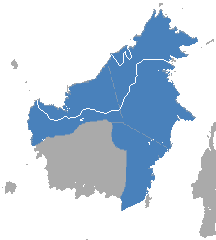Müller's gibbon
| Müller's gibbon[1] | |
|---|---|

| |
| At the Cincinnati Zoo | |
| Scientific classification | |
| Kingdom: | Animalia |
| Phylum: | Chordata |
| Class: | Mammalia |
| Order: | Primates |
| Suborder: | Haplorhini |
| Infraorder: | Simiiformes |
| Family: | Hylobatidae |
| Genus: | Hylobates |
| Species: | H. muelleri
|
| Binomial name | |
| Hylobates muelleri Martin, 1841
| |

| |
| Muller's gibbon range | |
Müller's gibbon (Hylobates muelleri),[2] also known as the grey gibbon, is a primate in the gibbon family, Hylobatidae.
Description[]
Unlike most gibbon species, Müller's gibbon does not show sexual dimorphism in its fur coloration. Its fur is grey- or brown-colored with a ring of bright fur around its face. On the head, it often has a darkly colored cap. Weighing between 4–8 kg, it ranks among the smaller of the gibbons.[3]

Distribution and habitat[]
Müller's gibbon is endemic to the island of Borneo, inhabiting the northern and eastern part of the island. Müller's gibbon occurs in a number of protected areas, including Betung Kerihun National Park, Bukit Baka Bukit Raya National Park, Kayan Mentarang National Park, Kutai National Park, Sungai Wain Protection Forest and Tanjung Puting National Park in Indonesia and Pulong Tau National Park[4] the Lanjak Entimau Wildlife Sanctuary and Semengok Forest Reserve in Malaysia.[2] In the southwest of the island lives the Bornean white-bearded gibbon; their territories hardly overlap.
Behaviour[]
Grey gibbons are diurnal rain forest dwellers, characterized by the long arms that all gibbons have, with which they brachiate through the trees. They live together in monogamous pairs, and defend their family territory against intruders with long, loud singing. Their diet consists primarily of fruits. Little is known about the reproductive patterns of this species, but it is thought to be similar to that of other gibbon species.[3]
References[]
- ^ Groves, C. P. (2005). Wilson, D. E.; Reeder, D. M. (eds.). Mammal Species of the World: A Taxonomic and Geographic Reference (3rd ed.). Baltimore: Johns Hopkins University Press. p. 180. ISBN 0-801-88221-4. OCLC 62265494.
- ^ Jump up to: a b c Marshall, A.J.; Nijman, V.; Cheyne, S.M. (2020). "Hylobates muelleri". IUCN Red List of Threatened Species. 2020: e.T39888A17990934. Retrieved 17 August 2020.
- ^ Jump up to: a b Bruening, S. Shefferly, N.; Parr, C. S. (eds.). "Hylobates muelleri: Information". Animal Diversity Web. Retrieved 2013-04-12.
- ^ Malaysian Nature Society 1998 Expedition to the proposed Pulong Tau National Park, Sarawak, Malaysia. Malaysian Nature Society, Miri Branch, Miri, Sarawak.
External links[]
| Wikispecies has information related to Müller's Bornean gibbon. |
- IUCN Red List endangered species
- Hylobates
- Primates of Indonesia
- Endemic fauna of Borneo
- Mammals of Borneo
- Mammals of Malaysia
- Mammals of Brunei
- Endangered fauna of Asia
- Species endangered by the pet trade
- Mammals described in 1841
- Taxa named by William Charles Linnaeus Martin
